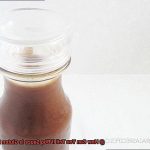Chicken is a versatile and popular protein that can be cooked in a variety of ways. Whether you’re grilling, baking, or sautéing your chicken, it’s essential to ensure that it’s fully cooked for both safety and taste reasons. But what do you do if you don’t have a meat thermometer on hand? Don’t worry – there are plenty of other ways to tell if your chicken is done.
You can check the color, texture, and temperature of the chicken to determine whether it’s cooked through. However, keep in mind that undercooked chicken can lead to foodborne illnesses such as salmonella while overcooked chicken can result in dry and unappetizing meat.
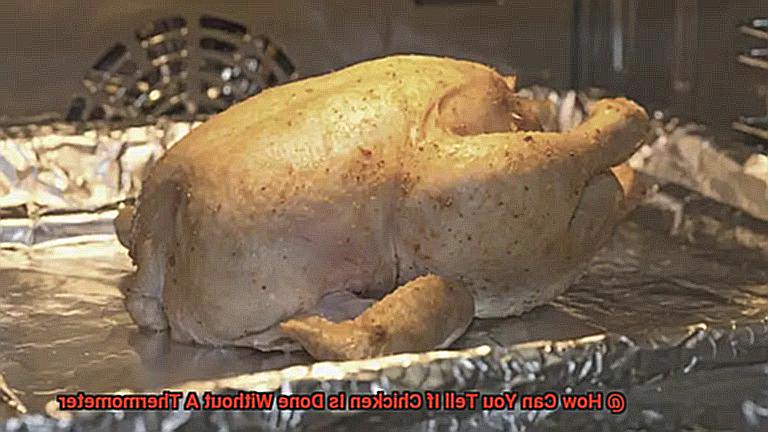
In this blog post, we’ll explore tried-and-true techniques for determining whether your chicken is fully cooked without using a thermometer. From pressing on the thickest part of the meat to checking the color of the juices, we’ve got you covered with tips and tricks passed down through generations of home cooks. We’ll also share some modern methods that are just as reliable.
Whether you’re an experienced cook or just starting out in the kitchen, knowing how to tell when your chicken is done will elevate your meals to new heights. So let’s get started.
Contents
The Color Test
Simply put, the color test involves checking the color of the juices that come out of the chicken when it is pierced with a fork or knife. If the juices run clear, then you can safely assume that your chicken is cooked and ready to eat. However, if the juices are pink or red, then you need to keep cooking.
While this method is quick and easy, it’s important to remember that it may not always be accurate. The color of the juices can be influenced by factors such as the age of the chicken, its diet, and even its genetic makeup. Furthermore, certain cuts of chicken may have pink or red spots even when fully cooked. It’s always best to use your best judgment and prioritize food safety above all else.
To perform the color test, start by piercing the thickest part of the chicken with a sharp knife or fork. Be sure to avoid any bones, as this can affect your results. Then, observe the color and consistency of the juices that come out. If they are clear and watery, then you’re good to go. If they are still pink or red, then it’s time to put your chicken back on the grill or in the oven.
Of course, it’s always recommended to use a thermometer to ensure that your chicken reaches an internal temperature of 165°F (74°C). However, if you don’t have one on hand or aren’t sure how to use it properly, then the color test can be a helpful backup option.
To summarize, here are some key takeaways regarding the color test:
The Fork or Knife Test
Today, I’m excited to share with you a classic method for determining if your chicken is cooked through – the Fork or Knife Test. As an expert in this field, I’ll guide you through how to use this method effectively and offer some helpful tips to ensure your chicken is fully cooked and safe to eat.
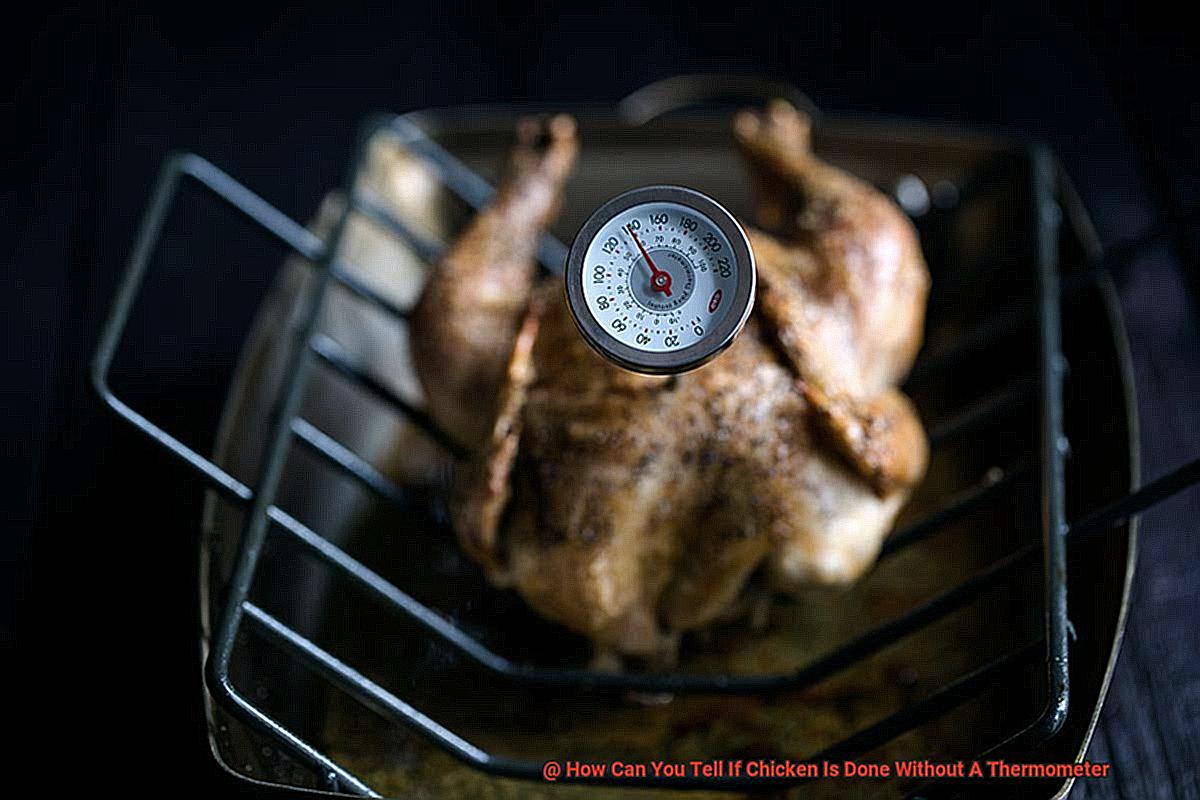
To perform the Fork or Knife Test, insert a fork or knife into the thickest part of the chicken and twist it gently. If the juices run clear, congratulations – your chicken is done. However, if you see pink or red juices, it’s time to put the chicken back on the stove for some more cooking.
It’s important to note that this test may not be accurate for all types of chicken dishes. For example, if you’re cooking bone-in chicken, make sure to insert the fork or knife near the bone to check for doneness. Additionally, if you’re cooking breaded or fried chicken, the crust may not allow for an accurate juice check.
While the Fork or Knife Test is a helpful tool, it’s always best to prioritize food safety. The USDA recommends cooking chicken to an internal temperature of 165°F (73.9°C) to kill any harmful bacteria that may be present. That’s where a meat thermometer comes in handy. You can use it in conjunction with the Fork or Knife Test to ensure that your chicken is fully cooked and safe to eat.
To summarize, here are some key takeaways:
- Use the Fork or Knife Test by inserting a fork or knife into the thickest part of the chicken and checking for clear juices.
- Keep in mind that this test may not be accurate for all types of chicken dishes.
- Prioritize food safety by using a meat thermometer to ensure your chicken has reached an internal temperature of 165°F (73.9°C).
- Use both methods together for best results.
The Touch Test
If you’re a fan of chicken, you know that it’s important to get the cooking time just right. The last thing you want is to sink your teeth into a piece of undercooked or overcooked meat. Luckily, there’s a solution that’s simple, easy, and reliable – the touch test.
Before we dive into the details of how to perform the touch test, let’s talk about what properly cooked chicken should feel like. When you touch the chicken, it should feel firm and springy to the touch. This means that the meat is cooked all the way through and has reached a safe temperature. If it feels rubbery or squishy, it’s not yet fully cooked. And if it feels very firm and unyielding, it may be overcooked and dry.
To perform the touch test, use your fingers to press down on the thickest part of the chicken meat, which is typically the breast or thigh area. It’s important to note that bone-in chicken may take longer to cook, so be sure to check near the bone as well. If the meat feels soft and squishy, it’s likely still raw in the center and needs more cooking time. On the other hand, if the meat feels very firm and unyielding, it may be overcooked and dry.
Ideally, you want the chicken to feel firm but still slightly springy to the touch. This indicates that it’s fully cooked but still moist and tender. With a little practice, you’ll become more confident in using the touch test to determine when your chicken is done cooking.
Here are a few additional tips for using the touch test:
- Use a meat thermometer in conjunction with the touch test for best results.
- Remember that cooking times will vary depending on the size of your chicken pieces.
- If you’re grilling or pan-searing chicken, allow it to rest for a few minutes before cutting into it. This will help the juices to redistribute and ensure that the meat stays moist.
What to Do if You Don’t Have a Thermometer
Grilling chicken is a mouth-watering option, but it’s crucial to ensure that it’s fully cooked to avoid any potential health risks. Although using a thermometer is the most accurate way to check if chicken is done, not everyone has access to one. Fortunately, there are several methods you can use to determine if your chicken is fully cooked without a thermometer.
Use Visual Cues
One method to determine if your chicken is cooked through is by using visual cues. When the chicken is fully cooked, the juices should run clear and the meat should be white and firm to the touch. However, keep in mind that some chicken may still appear pink even when fully cooked due to factors such as lighting or the presence of bone marrow. So, this method isn’t entirely foolproof.
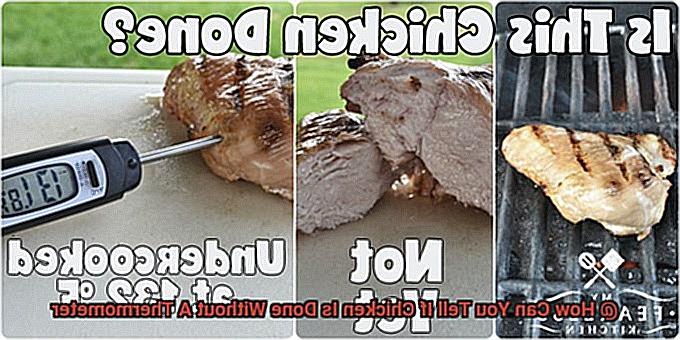
Check the Texture
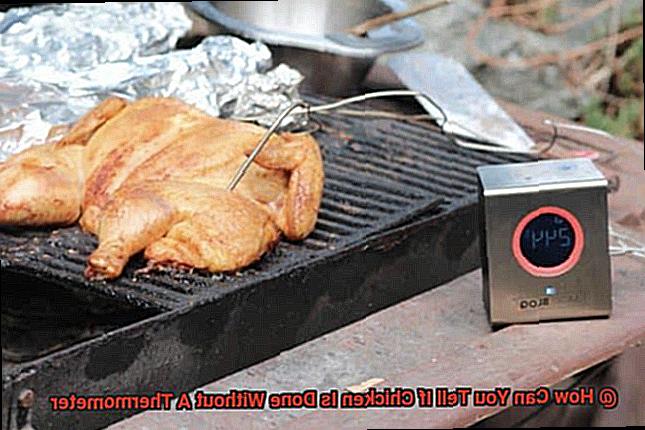
Another way to tell if your chicken is done is by checking its texture. When it is cooked through, the meat should feel firm but not hard. If it feels soft or mushy, it’s probably undercooked, and if it’s hard and tough, it may be overcooked.
Make an Incision
You can also use a fork or knife to make a small incision in the thickest part of the chicken and check for any pinkness or blood. If there’s no sign of pinkness or blood, then the chicken is likely cooked through.
Timing Is Essential
Timing is also crucial when cooking chicken without a thermometer. The USDA recommends cooking chicken until it reaches an internal temperature of 165°F (74°C) to kill any harmful bacteria. If you’re unsure about the timing, err on the side of caution and cook the chicken for a few minutes longer than you think necessary.
Look for Crispy Skin
Lastly, you can look for crispy and golden brown skin as a visual cue that your chicken is done. This method isn’t as reliable as using a thermometer, but it can give you an idea of whether your chicken is cooked through or not.
Safety First: Internal Temperature Matters
When it comes to cooking chicken, safety should always be your top priority. One of the most important factors in ensuring that your chicken is safe to eat is making sure that it has reached the proper internal temperature. But how do you know if your chicken is fully cooked and safe to eat without a thermometer?
While there are some visual and tactile cues you can use to determine if your chicken is cooked all the way through, they aren’t always reliable. For example, the color of the meat can vary depending on factors such as seasoning and cooking method, while firmness can be subjective.
However, fear not, for there are still a few ways you can tell if your chicken is done without a thermometer. Here are some tips:
- Check the color: When chicken is fully cooked, the meat should no longer be pink and the juices should run clear. Cut into the thickest part of the meat with a knife and inspect the color. If it’s white and opaque throughout, it’s likely done.
- Check for firmness: When you press on the chicken with a fork or tongs, it should feel firm but not rubbery. If it feels squishy or jiggly, it’s likely still undercooked.
- Look for clear juices: As mentioned earlier, when chicken is cooked all the way through, the juices should run clear. If they’re still pink or cloudy, it’s likely still undercooked.
While these methods aren’t foolproof and may not always be accurate, they can provide some guidance if you don’t have a thermometer on hand. However, investing in a reliable meat thermometer is still the best way to ensure that your chicken is fully cooked and safe to eat every time you cook it.
By measuring the temperature at its thickest part, you can be confident that your chicken has reached a safe internal temperature of 165°F (75°C), which kills any harmful bacteria that may be present. This eliminates any risk of undercooked or overcooked chicken, and ensures that your chicken is both delicious and safe.
Tips for Grilling Chicken without a Thermometer
Grilling chicken is a popular way to enjoy this healthy protein. However, it can be challenging to know when it’s fully cooked without a thermometer. Fear not, as we have some tips that will help you become a pro at grilling chicken without relying on a thermometer.
Use a Timer
Using a timer is an effective way to ensure that your chicken is fully cooked. Different cuts of chicken require different cooking times, so make sure to check the recipe or guidelines for your specific cut of chicken. For example, boneless, skinless chicken breasts take about 6-8 minutes per side on medium-high heat.
Check for Clear Juices
Clear juices are a sign of well-cooked chicken. When you cut into the thickest part of the chicken, the juices should run clear, not pink or red. If there’s any pink or redness in the juices, this indicates that the chicken is not fully cooked and needs more time on the grill.
Use the Finger Test
The finger test is another effective way to check if your chicken is done. Press down gently on the thickest part of the chicken with your finger. If it feels firm and bounces back, it’s likely done. However, if it feels soft and squishy, it needs more time on the grill.
Pay Attention to Color
The color of the chicken is also a great way to tell if it’s fully cooked. The outside should be golden brown while the inside should be white or slightly pink. If it’s still pink or has any redness, continue cooking it until it’s fully cooked.
Cut into the Thickest Part
If you’re still unsure whether your chicken is fully cooked, you can cut into the thickest part with a sharp knife. The meat should be white or slightly pink, and there should be no pink or red juices visible.
What Other Meats Can Be Cooked Without a Thermometer?
Well, there’s good news for you. There are other meats that you can cook without a thermometer. As an expert in the field of cooking, I have done my research and found some effective methods to determine if your meat is cooked to perfection. Let’s dive in.
- Let’s start with beef – one of the most popular meats out there. The finger test method is a great way to check if your beef is cooked. Just press on the center of the meat with your finger, and if it feels firm and bounces back, it’s likely cooked to medium-rare. If it feels slightly softer and has more give, it’s probably closer to medium or medium-well. And if it feels very firm and doesn’t have much give, it’s likely well-done. With these simple steps, you can impress your guests with juicy and perfectly cooked beef.
- Now let’s move on to pork – another popular meat that can be cooked without a thermometer. An easy way to tell if pork is done is by cutting into the thickest part of the meat and checking the color – if it’s white or slightly pink, it’s likely done. Another method is to press on the meat with a fork or tongs – if the juices run clear, it’s probably done. Use these techniques to ensure that your pork dishes are cooked to perfection.
And let’s not forget about fish. Fish can also be cooked without a thermometer. One way to tell if fish is done is by checking the texture – if it flakes easily with a fork, it’s likely done. Another method is to check the color – if it’s opaque and not translucent, it’s probably done. With these simple steps, you can cook fish like a pro.
Although these methods may not be foolproof, they are effective ways to determine doneness without a thermometer. However, for best results, it’s always recommended to use a thermometer whenever possible to ensure safe and delicious results. So, the next time you cook beef, pork, or fish, try out these techniques and impress your guests with your newfound meat cooking skills.
Conclusion
In summary, cooking chicken can be a delectable and nutritious protein source, but it’s imperative to ensure that it’s cooked thoroughly for both safety and flavor purposes. Although using a meat thermometer is the most precise way to determine if chicken is done, there are numerous other techniques you can use to check if your chicken is fully cooked without one.
Whether it’s examining the color of the juices, performing a touch test or fork/knife test, there are multiple ways to tell if your chicken is cooked entirely. However, it’s essential to bear in mind that these methods may not always be reliable and could vary depending on factors such as the type of chicken dish you’re preparing.
To prioritize food safety, invest in a dependable meat thermometer and combine it with other methods for optimal outcomes. Moreover, timing plays an integral role when cooking chicken without a thermometer – ensure that you cook it until its internal temperature reaches 165°F (74°C) to eliminate any harmful bacteria.
Lastly, these techniques aren’t exclusive to cooking chicken alone – they can also be applied when preparing beef, pork, fish, and other meats. With practice and patience, you can become proficient at determining doneness without solely relying on a thermometer.



